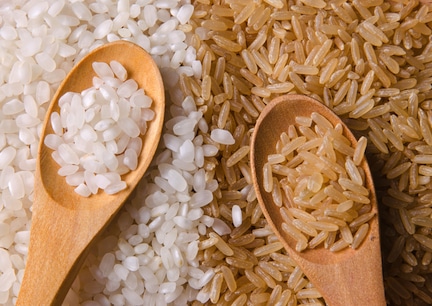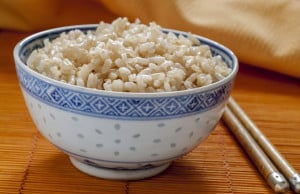
Brown rice is better for you than white — the evidence is compelling when you look at the top 10 health benefits of it that follow. The majority of consumers typically choose white rice over brown because of the difference in appearance.
While it’s true white rice might look more appealing to some than its brown relative, it doesn’t mean it’s the healthier alternative. According to a study conducted by the American Journal of Clinical Nutrition, brown rice is the top choice in terms of both nutritional and other inherent healthy benefits.
Why Brown Rice? Before white rice went through the refining process, it at one time looked exactly like the brown stuff. Brown, unlike white rice, still has the side hull and bran. The side hulls and brans provide “natural wholeness” to the grain and are rich in proteins, thiamine, calcium, magnesium, fiber, and potassium. For those trying to lose weight or those suffering from diabetes, it can prove a healthful staple given its low glycemic rating which helps reduce insulin spikes.
Unfortunately, all white rice packaging has a label that reads “enriched.” Since white rice has been stripped of iron, vitamins, zinc, magnesium and other nutrients during the refining process, manufacturers must add unnatural fortifications in the form of synthetic vitamins and iron so it can be marketed to the public as a “nutritious food.” Although white rice is fortified, it still doesn’t reach the minimum nutritional requirements for one serving of food as specified by the FDA. The healthy benefits of brown rice are listed below.
1. Rich in Selenium It is rich in selenium which reduces the risk for developing common illnesses such as cancer, heart disease and arthritis.
2. High in Manganese One cup of it provides 80% of our daily manganese requirements. Manganese helps the body synthesize fats. Manganese also benefits our nervous and reproductive systems.
3. Rich in Naturally-Occurring Oils Naturally occurring oils are beneficial for the body as these healthful fats help normalize cholesterol levels.
4. Promotes Weight Loss The fiber content of brown rice keeps bowel function at it’s peak since it makes digestion that much easier. It is the perfect addition to the daily diet for those seeking bowel regularity. In addition, it also makes the tummy feel full which translates to smaller meal portions.
5. Considered Whole Grain Brown rice is considered a whole grain since it hasn’t lost its “wholeness” through the refinement process. Whole grains are proven to reduce the buildup of arterial plaque and reduce the risk of heart disease and high cholesterol.
 6. Rich in Anti-Oxidants This is one of the best kept secrets regarding brown rice. We usually associate anti-oxidant rich foods with blueberries, strawberries and other fruits and vegetables. Its antioxidant capacity is right up there with these super stars.
6. Rich in Anti-Oxidants This is one of the best kept secrets regarding brown rice. We usually associate anti-oxidant rich foods with blueberries, strawberries and other fruits and vegetables. Its antioxidant capacity is right up there with these super stars.
7. High in Fiber It is high in fiber and on top of the list for foods that can help prevent colon cancer. This can be attributed to the high levels of fiber naturally contained in brown rice. These fibers attach to substances that cause cancer as well as to toxins in the body, thus eliminating them and keeping them from attaching to the colon wall.
8. A Slow-Release Sugar Brown rice helps stabilize blood sugar levels; therefore, it’s an excellent food choice for those suffering from diabetes. Studies show that those who consume one half cup eaten daily reduce their risks of developing diabetes by 60%. On the other hand, those who consume white rice regularly increase their chances of developing diabetes one hundred-fold.
9. Perfect Baby Food Brown rice cereal or even just by itself is the perfect baby’s first food due to the dense natural nutrition and fiber it contains. This is a much better choice than refined white rice cereal products as rapidly growing babies and toddlers require nutrient rich diets to help maintain rapid growth cycles.
10. Candida Yeast Infections It is the perfect adjunct for candida yeast infection treatmentsgiven that high glycemic and otherwise sugary/starchy foods are prohibited during most candida treatment protocols. Its natural digestibility coupled with the high fiber content can help sensitive digestive systems heal from an overgrowth of candida organisms. Finally, it is simply delicious and a fantastic staple for both vegetarian and vegan diets. It can be used as a white rice alternative in most vegetarian recipes and provides a full, rich and somewhat nutty flavor. Its flour can be used for vegetarian pancakes, breads and other baked goods. All in all, it is clearly the healthy choice.
Dr. Linda Kennedy MS SLP ND is an avid animal activist and nature lover.
How to Cook brown rice
The amount of water recommended for cooking long- and medium-grain brown rice varies depending on the source, from as little as 1½ parts water to as much as 3 parts water per 1 part rice. I’ve always preferred 2 1/2 parts water to 1 part rice. For example, 2 1/2 cups water to 1 cup rice.
Remember to rinse the rice well before cooking. Combine in a medium saucepan with the water. Bring to a slow boil, then lower the heat, Cover (leave lid ajar) and simmer for 30 minutes, or until the water is absorbed. If the rice isn’t tender to your liking at this point, add 1/2 cup additional water and continue to simmer until it’s absorbed.
Organic Brown Rice is available to purchase at SFMart.com
This article is originally posted on VegKitchen
